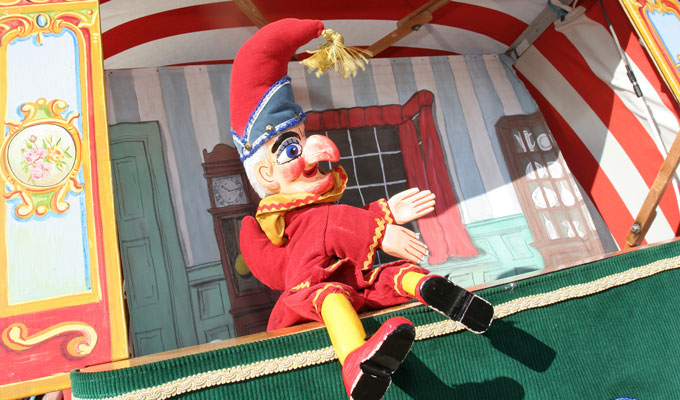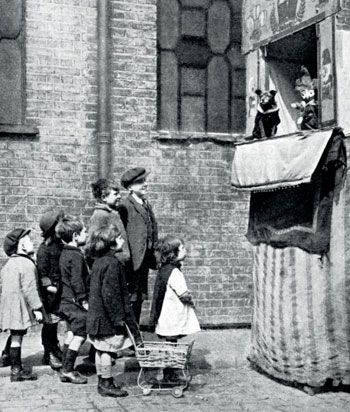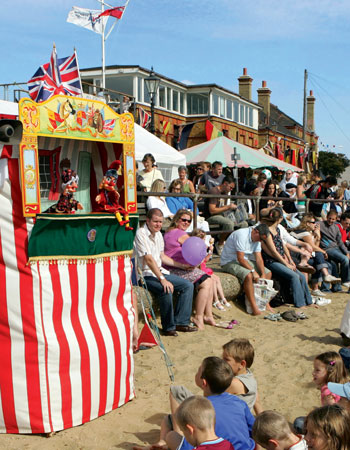In this, Mr Punch’s 350th birthday year, Professor Glyn Edwards tells us about the show’s origins and explains why this iconic British seaside symbol remains as popular as ever today

Professor Glyn Edwards’ first memories of Punch and Judy are from seaside shows he saw in the late 1940s; “My father was an entertainer, so my mother and I would spend the summer season in a flat at Brighton. Apparently I used to plead with my mother to take me to the show under the pier three times a day. I enjoyed some performances more than others and eventually discovered that there were two professors who took turns to do the shows.
“I was never impressed by people who said they didn’t like Punch and Judy shows. I knew it depended on the skill of the performer, not the characters. I became totally hooked by Mr Punch. His anarchic nature appealed to my rebellious streak and he seemed to me to be the embodiment of mischief.”
The first references to Mr Punch in Britain go much further back than Glyn’s earliest memories, some 350 years in fact. It was the diarist Samuel Pepys who stated, on 9 May 1662, that he had been “mighty pleased” by a puppet show he had seen in Covent Garden, which featured a raucous, irreverent hunchback character, with a pot belly and a wicked sense of humour called Pulcinella. It is from that Italian marionette that Mr Punch evolved, and it is from that diary entry that Mr Punch’s birthday is now traditionally calculated.

Glyn’s title of Professor may also have come from this era: King Charles II was a regular visitor to Covent Garden and it is said the king enjoyed the puppet shows so much that he passed a Royal Decree allowing Punch and Judy men to call themselves ‘Professor’. To this day Punch and Judy performers refer to themselves as Professors.
In the early 18th century Punch and Judy shows were commonly found in theatres. They also appeared in the back rooms of taverns and within large tents at England’s annual agricultural events. The use of heavy canvas structures and a need for a number of marionette assistants made the shows expensive and cumbersome to mount and transport. In the latter part of the 18th century, therefore, companies began to use glove puppets instead and started performing in narrow lightweight booths utilising just one puppeteer. The performer usually had an assistant, known as a ‘bottler’, to gather a crowd and collect money in a bottle. In this revitalised form, shows travelled throughout the country and were performed on street corners in London. At this time, the rollicking red-nosed rascal also adapted, going from a stringed comedian who might say outrageous things, to a more aggressive glove puppet.
The advent of the railways brought travel to the masses and took crowds to the seaside. This led Punch and Judy to head for the lucrative coast too. They soon made themselves as much part of traditional British beach fun as sand castles, paddling and donkey rides. Glyn reports that it was Mr Punch’s popularity at the seaside that led to ‘Oh I do like to be beside the seaside’ becoming his unofficial theme song. By the late 1940s, there were Punch and Judy shows at nearly every British seaside resort.
In the 1950s and 1960s, Punch and Judy remained popular at the seaside but began to spread to other locations again. Glyn recalls seeing Punch and Judy performed at the Festival of Britain in 1951. It was during the 1950s that he began to practise with puppets utilising a Punch and Judy set that his father had abandoned in the corner of his room. Glyn practised endlessly and found that he was able to work the puppets and the infamous swazzle which gives Punch his special high-pitched voice.

It was in a London park in 1961 that Glyn did his first paid public performance. “I absolutely loved it. I could see the audience laughing and heard them respond each time one of the characters asked whether Mr Punch had been naughty. The more shows I did after that, the more I understood why Old Red Nose had survived so long.”
Glyn was the youngest performer at the gathering in Covent Garden in 1962 where a plaque commemorating Mr Punch’s 300th birthday was unveiled. It is fitting therefore that Glyn, who now describes himself as a “Punch and Judy activist, 68 on the outside, but with an 11-year-old at the controls,” is now involved in organising the celebrations to mark Mr Punch’s 350th birthday. There is a range of nationwide exhibitions and talks taking place and a new permanent seaside exhibition has opened at Brighton’s Fishing Museum. These events, all under the banner of ‘The Big Grin’ have been funded by the Heritage Lottery fund and some form part of the Cultural Olympiad.
Such recognition highlights the enduring popularity of Britain’s iconic Punch and Judy show. Indeed when the Department of Culture, Media and Sport commissioned a project to identify Britain’s cultural treasures, Punch and Judy was announced as one of the first 12 icons of Englishness, ranked alongside a cup of tea and Stonehenge.
To claims that Punch and Judy are no longer politically correct and are in decline, Glyn disagrees, saying “It is because Punch is a puppet not a human that he can get away with such outrageous behaviour. All the professors I know were fully booked for the Jubilee celebrations.”
Whilst elements of the story, cast members and performance venues may have changed over time, Mr Punch’s triumphant catchphrase “That’s the way to do it” and the notorious “Oh no I didn’t Oh yes you did” banter have endured. Punch and Judy shows are a living social history, passed along the centuries by dedicated performers for the enjoyment of all. It is a simple and mischievous tale that remains genuinely funny and will no doubt continue to bring howls of laughter from appreciative audiences for many years to come. Happy 350th Birthday Mr Punch!





 © 2024
© 2024